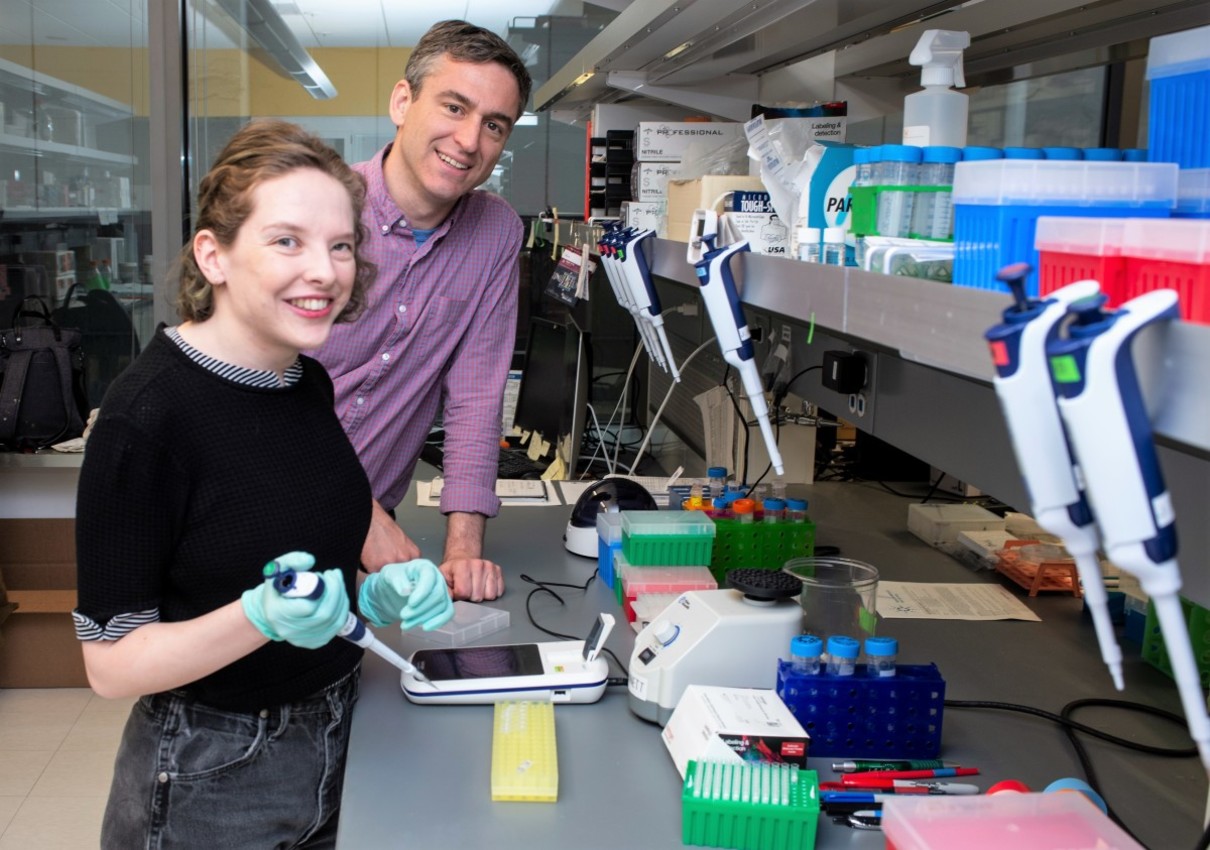 Dana Jensen and Dr. James Bennett (Photo courtesy of UW Center for Developmental Biology and Regenerative Medicine)
Dana Jensen and Dr. James Bennett (Photo courtesy of UW Center for Developmental Biology and Regenerative Medicine)
Dana Jensen has come full circle.
She was a patient at Seattle Children’s for the first 19 years of her life, enduring as many as 10 surgeries to help address a congenital disorder affecting the structure of her jaw. Nine years later at age 28, Jensen is a “model scientist,” working alongside Dr. James Bennett in his lab at Seattle Children’s focusing on the research and treatment of pediatric vascular malformations.
“I have a personal relationship with medicine,” Jensen said. “It’s not where I expected to end up, but it’s an important part of who I am.” Answering the question, “Who is Dana Jensen?” takes one on a journey as unconventional as it is fascinating.
Step one on that journey begins shortly after Jensen’s birth in February of 1994 when she was diagnosed with Hemifacial Microsomia, a condition primarily affecting the development of one side of the face; in her case, the jawbone. While the precise cause is unknown, research has pointed toward genetic mutations. The condition can affect the cheekbones, eyes, facial nerves, and muscles. It is the second-most common birth defect affecting the face, following cleft lip or palate.
“Throughout my childhood I had an incredible team of clinicians taking care of me and consulting with each other about what was best throughout my journey, many of whom I never even met,” she said “It feels amazing to now be in a similar position in research behind the scenes working to help kids with similar conditions.”
But Jensen’s desire to join such a team did not manifest itself until she started as an undergraduate at Western Washington University.
“I was an artsy kid and did not do well in science or math until I got to college,” she said.
At WWU, she initially took psychology classes, “but the subject just wasn’t connecting with me,” she said. “I wanted to study the actual mechanisms of people’s behavior, and I had to take a Chem 101 class. I realized I was good at it, and had been missing the excitement of the foundations of chemistry. It was a confidence boost. I just needed to be in this new environment.”
During the summers of 2015 and 2016, Jensen interned at Seattle Children’s and worked side-by-side in the lab with Bennett, who was then a post-doctoral researcher.
“What initially impressed me about Dana was that she picked up concepts and procedures so quickly,” said Bennett, assistant medical director of the Seattle Children’s Molecular Genetics Laboratory. “She was absolutely precise doing experiments.”
In December of 2017, Jensen graduated from WWU with a Bachelor of Science in Behavioral Neuroscience. She noted that “the combination of one-third biology, one-third chemistry, and one-third psychology was a perfect mix for me.”
If her degree was a “perfect mix, her work with Bennett and others at Seattle Children’s is the ideal combination of learning and practicing an evolving passion for molecular biology – both at the bench and “behind the scenes” in clinical settings.
Her responsibilities comprise four areas of Bennett’s lab:
• Designing, optimizing, executing, and analyzing data;
• Mentoring and supervising;
• Problem solving, both independently and leading others; and
• Managing lab functions.
Recognizing those skills, Bennett recently promoted Jensen from a research technician to a laboratory supervisor.
“My team and my research would not be where they are without Dana,” Bennett said. “She is thorough, meticulous, and organized. Her positive outlook is perfectly balanced with her empirical skepticism, making her a model scientist. Many senior people in our (Seattle Children's Research Division) could learn from her.”
'My brain is not wired – at least not now – to climb the PhD ladder.'
Fulfilling a 2022 professional goal, Jensen presented on her work in Vancouver, B.C. last May at the International Society for the Study of Vascular Anomalies. She, Bennett, and others from Seattle Children’s addressed the topic “Detection of PIK3CA mutations in aspirated cyst fluid is comparable to surgically resected tissues: Minimally invasive diagnostics for lymphatic malformations.” Not coincidentally, this subject represents the essence of the new “SpotSeq” test Bennett and colleagues are launching designed to diagnose genetic “hot spots” for mutations causing vascular malformations in children.
“Imagine being in a room of 300 people with some of the world’s top researchers and clinicians for understanding patients with vascular anomalies,” Bennett said. “Dana was one of the few people in the room without a graduate degree. One of the leading experts on vascular genetics asked her a question. She was completely at ease, answering the question brilliantly. It was a mic drop moment.”
So, what will Dana Jensen be doing in five years?
“In a position like mine, one typically does two or three years, then goes to grad school,” she said. “My brain is not wired – at least not now – to climb the PhD ladder. With the support and trust that Dr. Bennett has given me over the years, I’ve had incredible opportunities to present my work that many PhD candidates don’t get for years. In five years, I hope to have several first author papers on the work I’m doing now, and to be helping manage a bigger Bennett lab to even greater success.”


